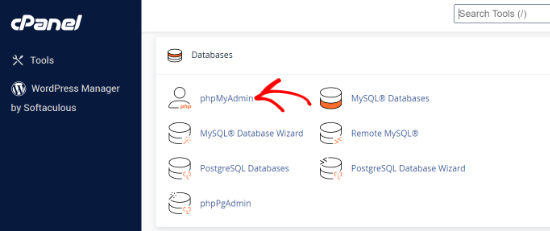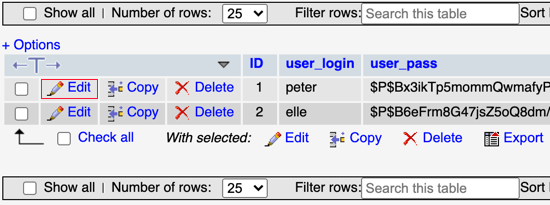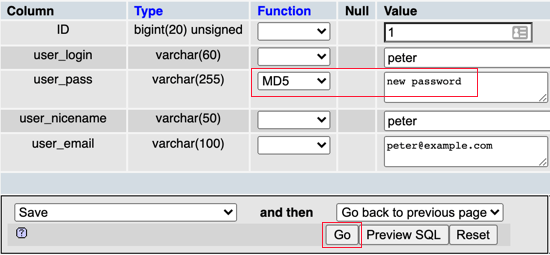Do you want to reset your WordPress password using phpMyAdmin?
If you are unable to reset your WordPress password, then there is a way to reset it directly in your WordPress database using phpMyAdmin.
In this article, we will show you how to easily reset a WordPress password from phpMyAdmin.

Why Reset a WordPress Password From phpMyAdmin?
WordPress makes it super easy to recover a lost password.
You can simply go to the login screen of your WordPress website and click on the ‘Lost your password?’ link.

When you click on the link you are taken to the password reset page. Once you enter your username or email address, WordPress will send a password reset link to the associated email address.
However, if you don’t have access to that email address, or your WordPress site fails to send an email, then you will not be able to reset your password.
In such a situation, you will need to reset your WordPress password directly in the database. The easiest way to do that is by using phpMyAdmin.
Having said that, let’s see how you can easily reset a WordPress password from phpMyAdmin.
How to Reset a WordPress Password From phpMyAdmin
If you don’t want to watch the video tutorial, then you can continue reading the text version below.
First, you need to log in to the cPanel dashboard of your WordPress hosting account. Next, you need to navigate to the Databases section where you can click on the phpMyAdmin icon.

This will launch the phpMyAdmin app.
Here you need to select your WordPress database from the left pane.

You will now see the list of tables in your WordPress database.
You need to look for the wp_users table in this list and click on the ‘Browse’ link next to it.

Note: Table names in your WordPress database may have a different prefix than the one we are showing in our screenshot. Changing table prefixes can improve the security of your WordPress site.
You will now see the rows in your WordPress users table. Go ahead and click on the edit button next to the username whose password you wish to change.

PhpMyAdmin will show you a form with all the user information fields.
You will need to delete the value in the user_pass field and replace it with your new password. Under the function column, select MD5 from the drop-down menu and then click on the Go button at the bottom of the form.

Your password will be encrypted using the MD5 hash and then it will be stored in the database.
Congratulations! You have successfully changed your WordPress password using phpMyAdmin.
Some of you may be wondering why we selected the MD5 hash to encrypt the password. WordPress previously used MD5 hash to encrypt passwords, but since WordPress 2.5 it has been using stronger encryption technologies.
However, WordPress still recognizes MD5 to provide backward compatibility. As soon as you log in using a password string stored as an MD5 hash, WordPress will automatically change it to use the newer encryption algorithms.
Expert Guides on Passwords in WordPress
Now that you know how to reset a WordPress password from phpMyAdmin, you may wish to see some other articles related to passwords in WordPress.
- How to Change Your Password in WordPress (Beginner’s Guide)
- How to Reset Passwords for All Users in WordPress
- How to Customize the WordPress Reset Password Page
- How to Force Users to Change Passwords in WordPress – Expire Password
- Forgot Password? How to Recover a Lost Password in WordPress
- How to Force Strong Passwords on Users in WordPress
- How to Add Two-Factor Authentication in WordPress (Free Method)
- How to Allow Users to Hide/Show Passwords on WordPress Login Screen
- How to Easily and Securely Manage Passwords (Beginner’s Guide)
We hope this tutorial helped you learn how to reset a WordPress password from phpMyAdmin. You may also want to see our ultimate step-by-step WordPress security guide to keep your WordPress site safe or our expert pick of must-have plugins.
If you liked this article, then please subscribe to our YouTube Channel for WordPress video tutorials. You can also find us on Twitter and Facebook.





Syed Balkhi says
Hey WPBeginner readers,
Did you know you can win exciting prizes by commenting on WPBeginner?
Every month, our top blog commenters will win HUGE rewards, including premium WordPress plugin licenses and cash prizes.
You can get more details about the contest from here.
Start sharing your thoughts below to stand a chance to win!
Graham says
THANK YOU!!
I was caught up on the md5 encryption of the pw field. This really save my tail. I was using a member profile update which stripped all the email fields. This in turn also stripped mine and poof! Everyone’s password was deleted.
Seriously.
So, thank you a lot.
-Graham
Karen Seet says
How do I find my “hosting provider” so I can get to phpmyadmin? I am new to this.
Muhammad Talha says
Thanks a lot!
Edwin Calimlim says
Great post, i wasn’t able to access my WP site for months already but thanks to this post, it is really a big help for me. Thank you.
atif shahab says
Thanks alot. I was worried and stuck as well as i was unable to acess my WordPress dashboard for 2 hours. your recipe worked quickly. Thanks once again
WPBeginner Support says
Glad it helped you solve the issue
Admin
Niculina says
Thanks!! it worked! :):)
Joel says
Lifesaver, thank you!
alan says
What a fantastic email, new to C-panel but this tutorial was so clear I did it first time.
Great job.
Regards,
Alan
Trevor says
Thank you !!!
Pedro says
Did this now Jetpack gives me this error :
Jetpack could not contact WordPress.com: register_http_request_failed. This usually means something is incorrectly configured on your web host.
Operation timed out after 15000 milliseconds with 0 bytes received
Any tips on this?
Margie says
Thank you so much. The instructions were easy enough for even me to follow
Carina says
I wish it worked for me……I followed the directions [easy] but when I went to put in the MD5 hash numbers, they were exactly the same as what was already in the field value. This tells me that my problem is then not entering my user name and password that is the problem, but something completely different. …..:(
Thom Burlington says
Thank you, but ..
while I can now reset the password with the MD5 code, derived from the new password I created, say, “abc” , and I finish and go back to my wordpress adimin signin:
domain.org/wp-admin : username ; password
for the password do I now use “abc” ?
Thom Burlington says
Yes the password is “abc” – very nice – between your post and the video you are very clear, thank you.
Neal Kelshaw says
Not quite correct. If you choose MD5 as the function in the drop down menu, and then type the password in plain text it hashes the value to an MD5 value.
tobi says
awesome post thanks a lot
Jon O says
Just wanted to say a BIG thank you for this article! I was indeed hacked and had sought assistance from my hosting company and others.. but this article was the only straight forward approach that worked first time! Thanks so much!
WPBeginner Support says
Glad you found it helpful.
Admin
Tanya says
I spent hours trying to find a website to explain why I was logged onto my WP then 5 minutes later I couldn’t log onto it again.
Thank you so much for the simple video. Problem solved in 5 minutes!
You rock!
WPBeginner Support says
Glad you found it helpful.
Admin
Creina says
Thank you. For anyone that finds the video confusing just follow the written instructions.
ashish says
thank you so much for this tutorial…
Dairick says
Thank you for this turorial
Parbat Devkota says
thank you work charm.
Alexandra Jones says
I’m the dunce from Mars who can’t speak computer. I’ll start with this:
“The best place to look is your wp-config.php file which is located in your root WordPress Directory.”
OK–where is it and how do I get there? I can’t log into my site because it will not any accept any password resets. I tried Chris’s phone method and got in on my phone, but not on my laptop. and when I tried to post something on the phone, I got a message that I should install the latest Jetpack, but I had to log into WordPress again, and guess what–“Invalid username.”
Is any of you who found these instructions such a breeze willing to speak to me on the phone? I’m writing from my wit’s end. That’s where I am. I would so appreciate it! Cheers!
WPBeginner Support says
wp-config.php file resides on your web server. You can login to your web hosting control panel, locate the file manager, and then locate wp-config.php file. Alternately, you can also edit it using an FTP client.
Admin
Zania says
Thank You! Thank You! Easy and worked like a charm!
chrismj06 says
You have saved my life. Bless u!
Jill says
Thanks, you’re a lifesaver and this was easy to follow!
Kristen says
You saved the day! Thank you!
AMIT KUMAR says
Thank you ! I was simply trying to enter password. I never knew about the MD5 concept. Thanks again for a great tutorial.
Silviu says
Thank you
Dubb says
Awesome…you have saved the day once again my friend
Nigel says
Awesome, thanks.
Skye says
THANK YOU!!!!! Great article!
Kumar says
Work like charm!!
hendriyana says
Thanx !!! awesome.. helped for my problem….
Jaykesh says
Amazing, thanks for quick help.
luis says
Thanks a lot, I went into php admin and copy pasted the md5 password and i am in…..good job!
Muniyappa says
Thank you very much..
Tony Garcia says
A client’s developer passed away while on vacation of all things. You can only imagine what happened after that. Nobody knew anything of how their developer was doing things. Luckily I was able to locate where their databases were and got access to their PHPMyAdmin.
Voila!!! I have both of their lost sites back up and running with access to the back-ends because of this post.
Thank you!!!
Carol Long says
Thank you! Life saver!
Lori says
This saved me ENDLESS time. I’m not a tech novice but I am a novice at coding. These step by step instructions helped me regain access to my site! After losing access due to a “auto correct” error. (long story)
Thank you again!
christian gibson says
You say that WordPress generates an MD5 encryption of your password? But I seem to remember seeing somewhere on Stackoverflow that this is no longer true. They said: “The WordPress password hasher implements the Portable PHP password hashing framework, which is used in Content Management Systems like WordPress and Drupal”.
I know very little about encryption/decryption systems, but one thing does seem strange. In a WordPress website database you can can see in the user table a field called ‘user-pass’ with contents like ‘$P$BlBAsz6jcvS3rLGDiE81PwtwbEazKg1’.
All the hash values in this table begin with $P$B….. so what on earth is the point of including these leading 4 characters if they are all the same……?
Samson says
Thank you very much. saved me valuable time
Rod Salm says
As always, straight forward, very helpful tutorials. Right to the point and bang on accurate. Like this phpadmin tip for passwords.
Thank you!
Ben Glancy says
Or, if your admin account is the usual ID=1.
Open functions.php and put this code in
wp_set_password( “mypassword”, 1 );
Reload the page.
Uncomment code. Done.
Diana says
Soooo helpful! Thank you!!!!
raaga says
Thanks man. Very useful article.
Matthew Harris says
Thanks for the tip, I couldn’t quite remember. Here is a return tip for you:
You don’t need the external MD5 tool. Look on the screenshot there is a “Function” column with drop down boxes. On the user_pass field just select MD5 in the function column and type your new password in normal plain text in the input box next to it. When you save it phpMyAdmin will automatically md5 hash it for you.
Amir says
Great article. I found Matthew Harris’ tip simpler and tested it to work as well. Thanks!
Julian says
Mr. Harris approach worked like a charm! Thank you.
Kevin B. says
Very helpful. As a non-technical user, I felt powerless when an errant designer wouldn’t respond to my requests for passwords; this page with instructions filled the bill perfectly!
Many thanks,
KB
alex says
Thanks!
Gustavo says
Thanks for this great tip. I tried the “easiest” way above but couldn´t retrieve the automatic email because of some misterious server glitch.
I don´t know beans of PhP, so this kind of article is very useful for us.
Chris says
I found the easiest and fastest work around the “Sorry, that key does not appear to be valid” issue to reset your WordPress password using your cell phone.
1.) Just use your cell phone to access your password reset email that was sent to you.
2.) Click on the link in the email. The link will automatically open the site where you can input your new password.
3.) Follow the prompts to enter your new password.
4.) Save your new password
5.) You should now be able to access your WordPress website with your new password from any computer, business as usual.
I hope this helps everybody!